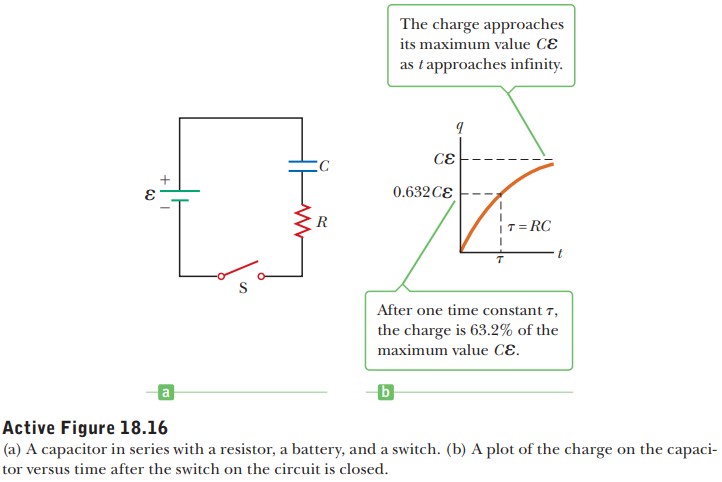Question 18.6: Charging a Capacitor in an RC Circuit GOAL Calculate element...
Charging a Capacitor in an RC Circuit
GOAL Calculate elementary properties of a simple RC circuit.
PROBLEM An uncharged capacitor and a resistor are connected in series to a battery, as in Active Figure 18.16a. If E = 12.0 V, C = 5.00 μF, and R = 8.00 × 105 Ω, find (a) the time constant of the circuit, (b) the maximum charge on the capacitor, (c) the charge on the capacitor after 6.00 s, (d) the potential difference across the resistor after 6.00 s, and (e) the current in the resistor at that time.
STRATEGY Finding the time constant in part (a) requires substitution into Equation 18.8.
τ=RC [18.8]
For part (b), the maximum charge occurs after a long time, when the current has dropped to zero. By Ohm’s law, ΔV = IR, the potential difference across the resistor is also zero at that time, and Kirchhoff’s loop rule then gives the maximum charge. Finding the charge at some particular time, as in part (c), is a matter of substituting into Equation 18.7.
q=Q(1−e−t/RC) [18.7]
Kirchhoff’s loop rule and the capacitance equation can be used to indirectly find the potential drop across the resistor in part (d), and then Ohm’s law yields the current.

Learn more on how we answer questions.
(a) Find the time constant of the circuit.
Use the definition of the time constant, Equation 18.8:
τ=RC=(8.00×105Ω)(5.00×10−6F)=4.00s
(b) Calculate the maximum charge on the capacitor.
Apply Kirchhoff’s loop rule to the RC circuit, going clockwise, which means that the voltage difference across the battery is positive and the differences across the capacitor and resistor are negative:
(1) ΔVbat+ΔVc+ΔVR=0
From the definition of capacitance (Eq. 16.8) and Ohm’s law, we have ΔVC=−q/C and ΔVR=−IR. These are voltage drops, so they’re negative. Also, ΔVbat=+E.
C≡ΔVQ [16.8]
(2)E−Cq−IR=0
When the maximum charge q = Q is reached, I = 0. Solve Equation (2) for the maximum charge:
E−CQ=0→Q=CE
Substitute to find the maximum charge:
Q=(5.00×10−6F)(12.0V)=60.0μC
(c) Find the charge on the capacitor after 6.00 s.
Substitute into Equation 18.7:
q=Q(1−e−t/τ)=(60.0μC)(1−e−6.00s/4.00s)
= 46.6 μC
(d) Compute the potential difference across the resistor after 6.00 s.
Compute the voltage drop ΔVC across the capacitor at that time:
ΔVC=−Cq=− 5.00 μF46.6 μC=−9.32V
Solve Equation (1) for ΔVC and substitute:
ΔVR=−ΔVbat−ΔVC=−12.0V−(−9.32V)
= -2.68 V
(e) Find the current in the resistor after 6.00 s.
Apply Ohm’s law, using the results of part (d) (remember that ΔVR = -IR here):
I=R−ΔVR=(8.00 × 105Ω)−(−2.68V)
= 3.35×10−6A
REMARKS In solving this problem, we paid scrupulous attention to signs. These signs must always be chosen when applying Kirchhoff’s loop rule and must remain consistent throughout the problem. Alternately, magnitudes can be used and the signs chosen by physical intuition. For example, the magnitude of the potential difference across the resistor must equal the magnitude of the potential difference across the battery minus the magnitude of the potential difference across the capacitor.